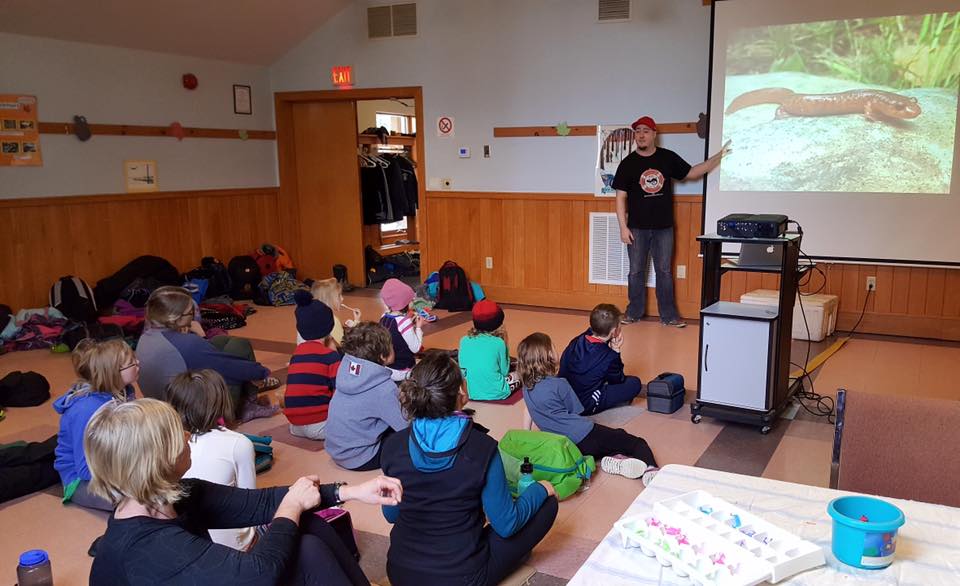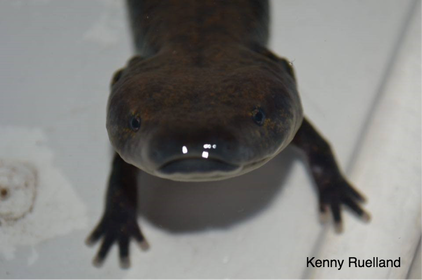|
By Matt Ellerbeck When I was small child, I lived in the Greater Toronto Area in southern Ontario. As such, the urban sprawl that accompanied this region did not leave me many places to explore and connect with nature. I would spend my summers visiting family at campgrounds. It was here that I encountered my first ever salamander, a Red Eft (Notophthalmus viridescens). I was instantly enthralled by this charming amphibian. Years later, the memory of my first salamander encounter is still very vibrant in my mind. It is a testament to my passion for these creatures! This passion lead me to start my outreach education project: Save The Salamanders. The goal of my project is to raise awareness among the general public that many salamanders are in decline and in need of conservation. I promote behavioural changes, habitat management, and environmental stewardship. These are ways that individuals can help contribute to the conservation of salamanders. I strive to empower the public and encourage them to get active with the recovery of species. Outreach education is important. The Amphibian and Reptile Conservancy (ARC) recognizes the need to increase awareness, appreciation, and understanding of amphibians, reptiles and their habitats. This education can then enhance conservation actions and stewardship practices. The Amphibian and Reptile Conservation Trust also proclaims that education is one of the most important tools in the long-term conservation of amphibians and reptiles. Raising awareness, enhancing knowledge and encouraging people to take action, are important steps towards conserving amphibian and reptile species. This is why I have made it one of my top priorities. Aside from my Save The Salamanders project, I am also a partner of the Amphibian Survival Alliance (ASA). The ASA is the world's largest partnership for amphibian conservation. The Amphibian Ark (AArk) also featured me as one of their Amphibian Ambassadors. The AArk is a joint effort of several principal partners. This includes the World Association of Zoos and Aquariums and the IUCN Conservation Breeding Specialist Group. My efforts to contribute to the betterment of salamanders earned me the nickname Salamander Man. British author, Claire McClennan wrote about my salamander conservation efforts in her book: Another Chance Animal Rescues - Book 2 (2012). It was here that I was first referred to as Salamander Man. Since that time it has become my moniker. The nickname has become a favourite among children, who are often one of my target audiences. This is important according to the Canadian Environmental Grantmakers' Network. Environmental education focused on children and youth is a particularly important strategy. It's an opportunity to intervene at a key developmental stage of life. Children can also be an important influence on their parents’ environmental behaviour. Throughout my outreach education, I have heard time and time again from individuals of varying ages, “I didn’t know we even had salamanders here!” This statement alone represents one of the biggest hurdles salamanders face, lack of attention. Worldwide there are some 600 different species. Of these species, around half are listed as at risk of extinction by the International Union for Conservation of Nature (IUCN). But how can people want to protect what they are not aware of? This is why I aimed to bring as much focus to the cause as possible. As such, I have appeared on TV, radio shows, and in many newspapers and publications across North America and Europe. This include high profile radio shows such as CBC in Ontario. I also appeared on Talking Animals, which airs in Tampa, Florida. The guests featured on this show tend to be prominent figures in the animal world, or notable celebrities who have ties to animal welfare. Past guests have included Jane Goodall, Chrissie Hynde, Paul Watson, Janeane Garofalo, Moby, Margaret Cho, and many others. I was also featured on Animals Today radio, which airs across 17 states, and on CiTR 101 FM, which provides listening to a base of over 2 million. I sincerely hope my efforts will contribute to the betterment of salamanders. And that it will inspire others to do the same!
2 Comments
By Jessica Ferguson Amphibians are cool. They were the first vertebrate to step out of the water, become terrestrial, and sprout some limbs and lungs (thanks, amphibians!). They are widely distributed, and can be found on every continent except Antarctica. They are indicator species, as they are sensitive to pollutants present in the water. Their early life-stage development is a throwback, indicating that they were once fully aquatic. There is incredible diversity in amphibians and their reproductive processes, but to summarize greatly, they lay eggs in the water, which hatch into aquatic larva equipped with gills, and later transform into their mostly-terrestrial adult stage complete with lungs. That is true for many Ontario amphibians, but not for the Mudpuppy (Necturus macolosus). This unique, fully aquatic salamander lays eggs in late spring, which are then possibly guarded by the females… who possibly stay with the young for a while after they hatch… We’re not completely sure, but more on that later. They take two to six years to fully transform into adults, and live for about 30 years. Although Mudpuppies can breathe oxygen through their skin like other amphibians, they retain their external, feathery, red gills into adulthood. This is the key identification feature for the species. Additionally, they are much larger than our other Ontario salamanders, reaching almost 50 cm in length. Even as juveniles they are about twice the size of the larva of other species. They have thick bodies and stubby legs, adorable beady little eyes, and are grey to rusty brown in colour with dark spots on their dorsal and lateral surfaces. Mudpuppies enjoy long walks along muddy river bottoms, and hiding under submerged rocks and logs. They are found in aquatic environments that don’t fully freeze in the winter. In fact, contrary to the behaviour of their hibernating cousins, they are actually active during the cold winter months. They are also carnivores and like to snack on aquatic insects, fish, fish eggs, worms, and crayfish. But here’s the thing: other than that, we actually don’t know very much about Mudpuppies. Because they are nocturnal and lay low at the bottom of waterbodies, they are seldom seen. Despite their elusive nature, we can still determine, through surveying efforts, that they are not a species at risk. They are not immune to the pressures that face their semi-terrestrial cousins, though. Pollution is a major issue, as is the case for all amphibians due to their incredibly porous skin. In the St. Lawrence River, over 60% of Mudpuppies examined had evidence of deformities due to high PCB levels (Fisher et al, 2007). Habitat loss and shoreline development are also problematic. However, an extra pressure Mudpuppies face is that they are often killed when caught by anglers who mistakenly believe them to be venomous. Mudpuppies are completely harmless. If you ever catch a Mudpuppy while fishing, gently take it off the hook, and release it back into the watery depths from whence it came. If you are unsure if it is a Mudpuppy or a fish…well, Mudpuppies have legs! There are very few reasons I would plunge my hands into icy water, but I have for a Mudpuppy. Despite scouring river bottoms, I have not yet had the chance to see one in the wild so I went to my friend, Kenny Ruelland, for his first experience with these cryptic creatures. Kenny said, "I will never forget my first time seeing one of these giant, neotenic (aquatic) salamanders. It was early March, the temperatures were around -25C. After about 40 minutes of wading through the icy water - there it was! My first ever Mudpuppy came emerging from under a sheet of ice." Finding excitement in such a strange creature may seem odd to some, but I’m sure that many have felt the same surge when they spot an owl hiding in the treetops, or watch a moose raise its head to solemnly watch you paddle by. Amphibians play an important role in our ecosystems, and we need to encourage people to be passionate about them to conserve the species and their habitats. Because there is so little known about Mudpuppies, every little bit helps. If you see one (or any reptile or amphibian in Ontario), report your sighting to the Ontario Reptile and Amphibian Atlas. Even incidental sightings can really help shed some light on this unique and under-surveyed species! This blog is also posted on Earth Unfiltered.
|
ELB MembersBlogs are written by ELB members who want to share their stories about Ontario's biodiversity. Archives
January 2023
Categories
All
|








 RSS Feed
RSS Feed